Scientists
Meet the scientists who will be answering questions during our live, interactive program on March 14 at Luray Caverns in Virginia.
Answering questions LIVE from Luray Caverns in Virginia:
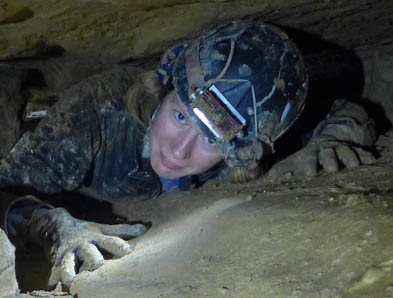
Dr. Johanna Kovarik
National Cave and Karst Program Lead, USDA Forest Service
Dr. Johanna Kovarik has served for the past six years as the National Cave and Karst Program Lead for the U.S. Forest Service, moving into this role from her work as a geologist and hydrologist on the Tongass National Forest in southeast Alaska. She has also led the National Groundwater Program and managed the GeoCorps internship program for the agency. From 2010 to 2015 she worked on a multi-faceted project in southern Mexico with the Forest Service's Office of International Programs, and in 2015 she was awarded the National Rise to the Future: Friend of Fish and Watershed Award from the U.S. Forest Service for her national and international work with karst watersheds. Johanna first started caving when she was hired for a Student Conservation Association internship at Carlsbad Caverns National Park.
Johanna's master's degree is in Geoscience from Western Kentucky University, and her Ph.D. is from the School of Geosciences at the University of South Florida. Her research work is primarily in land use and watershed dynamics, groundwater vulnerability, human disturbance, and natural resource management. She is a fellow of the National Speleological Society and enjoys mapping and studying caves around the world.
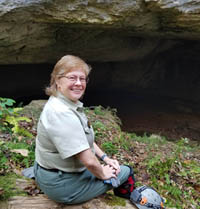
Barbara Beasley
Paleontologist, USDA Forest Service
Barb Beasley is a paleontologist with the USDA Forest Service. She received B.S. from University of Tennessee at Martin, TN in 1988, in Geosciences with a concentration in Geology and received a M.S. from Fort Hays State University, Hays KS, in 1993, in Earth Sciences with concentration in Vertebrate Paleontology. Barb was hired by U.S. Forest Service in a student coop position in 1992 located on the Nebraska National Forests and Grasslands (1st paleontologist in Department of Agriculture) and became a permanent employee in 1994. Barb has remained on the Nebraska, with her area of responsibility increasing to the current position of Minerals and Geology Management Staff; Paleontologist, Detached Washington Office. Her area of responsibility now includes National Forests and National Grasslands in Regions 1, 6, 9 and 10; and the northern portion of Region 2.
Some of Barb's duties include assisting the Forest Service staff with paleontological work such as permits, partnerships with State and Federal Agencies, Law Enforcement, training, agency policy development, and development of a national paleontological database. Barb also leads volunteer paleontological excavations on USFS lands and fossil preparation projects with partnering museums.
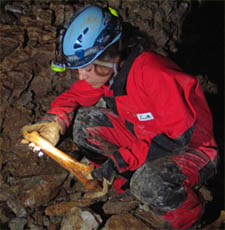
Limaris "Lima" Soto
Geologist, National Park Service
Limaris "Lima" Soto is the program assistant for two National Park Service (NPS) internships Geoscientists-in-the-Parks and Mosaics in Science with the Geologic Resources Division. Lima has a Bachelor's degree in Geology from the University of Puerto Rico- Mayagüez where she measured karst denudation rates of the Tanamá River in the northern aquifer of the island. Lima received a Master's degree in Geology from the University of South Florida, completing the first paleoclimate research using speleothems for the state of Florida. After graduation, Lima worked as a senior project manager responsible for geotechnical and geologic investigations related to identification of the causes of subsidence in karst environments. In 2013, she became a volunteer with the NPS National Cave and Karst Program in Denver, Colorado. Lima's first caving experience was during a sixth grade field trip in her hometown of Camuy, Puerto Rico. She is the co-author of the NPS Junior Cave Scientist Program and manages the distribution of this program.
Responding to Questions LIVE Online:

Gretchen Baker
Ecologist, Great Basin National Park
Gretchen Baker is an ecologist at Great Basin National Park. She started visiting caves when she was a child on summer vacation with her family. When she was 20, she got a summer job at Jewel Cave National Monument and knew she wanted to keep working in and near caves. She has helped find new species of cave life and is always excited to see what lives underground.
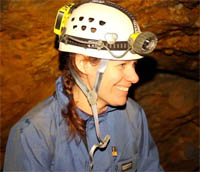
Dr. Hazel Barton
Professor/Director of Integrated Bioscience Program, Department of Biology, University of Akron
Dr. Barton was the star of "Journey into Amazing Caves" the IMAX film on caves and exploration. Check it out here: http://www.amazingcaves.com/home.htm Dr. Barton's research is geared toward understanding microbial interactions and adaptations to nutrient-limitation, as experienced by ecosystems in deep subsurface cave environments (see Dr. Barton's cave science site). This work has been funded by the US National Science Foundation (NSF) and US National Park Service.
The other research in the lab aims to understand the ecology and evolution of the fungus Pseudogymnoascus destructans, the causative agent of the White-nose Syndrome epidemic in bats. This research is funded by the US Fish and Wildlife Service.
The Barton Lab has been recognized as one of the "top ten most awesome research labs" by Popular Science magazine. Dr. Barton is also an avid caver, having explored caves on five continents, is a past director of the National Speleological Society (NSS), the Quintana Roo Speleological Survey, and an award-winning cave cartographer. Her cave research has been featured in Sports Illustrated, Forbes, National Geographic Explorer, Outside, Science News, The Scientist, Popular Mechanics, Wired, Geo and The Smithsonian magazines, in the book Extreme Scientists: Exploring Natures Mysteries from Perilous Places, on NPR and BBC Radio, on Animal Planet, the History Channel, the CBS Early Show, BBC TV and in the IMAX movie Journey into Amazing Caves.
Dr. Barton is currently a Fellow of the National Speleological Society, a Kavli Fellow of the American Academy for the Advancement of Science, Chair of the Committee on the Status of Women in Microbiology for the American Society for Microbiology, and the recipient of an NSF CAREER Award.
.jpg)
Fernando Hernandez
Hydrogeology Graduate Student, Western Kentucky University
Fernando Hernandez grew up in Monterrey, Mexico where he loved to search for fossils and peek underneath rocks to see what kind of bugs lived there. Eventually, his interest in the rock climbing and being outdoors led him to study Renewable Natural Resources at Texas A&M University. Between classes, he discovered the world of caves and soon found himself exploring, digging, and mapping caves nearly every weekend. This interest brought him to work in caves and springs with Austin's Watershed Protection Department, later as a Wildland Conservation karst biologist, and to volunteer in deep caving expeditions in Mexico. Now he studies hydrogeology at Western Kentucky University. His interest in looking at bugs is still strong. In his free time he likes to see what new species of arthropods can be found in the deepest caves in Mexico.
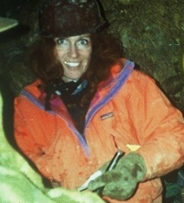
Dr. Risa Carlson
Archaeologist, USDA Forest Service
Risa Carlson has been an archaeologist for 38 years working throughout Alaska, with 15 of those years with the U.S. Forest Service in Southeast Alaska. She received her B.S. from the University of Alaska, returning to school many years later for masters and Ph.D. degrees in archaeology from the University of Cambridge, U.K. Risa's family moved to a remote village on Prince of Wales Island in 1968 where she and her sister spent many hours on the water and exploring the forest. In the early 1990s, she was part of the Tongass Cave Project, searching for new caves with the cavers and recording the cultural resources within. Now she focuses on early Holocene archaeological sites in the same area, reveling in the joy of always learning new things.
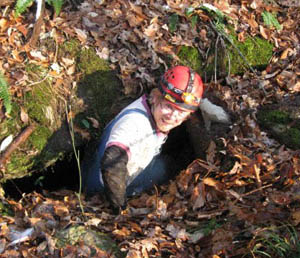
Ben Miller
Karst Hydrologist, U.S. Geological Survey
Ben Miller is a karst hydrologist working with the U.S. Geological Survey (USGS) Lower Mississippi-Gulf Water Science Center in Nashville, Tennessee. Ben has an undergraduate degree from the University of Missouri-Columbia and a Master's degree in Hydrology and Geomorphology from Western Kentucky University. Prior to working at the USGS, Ben worked in the fields of natural resource management, interpretation, karst research, and cave management. Ben is an avid cave mapper who has mapped over 450 caves and spends much of his free time mapping caves and studying large springs. Ben got started caving at the age of 8 with the Boy Scouts of America and his first wild cave trip was in Fitton Cave, the longest cave in Arkansas. The caving "bug" bit Ben hard and to this day he loves documenting caves that have never been discovered and surveying the passages of caves to learn more about how these unique environments formed.
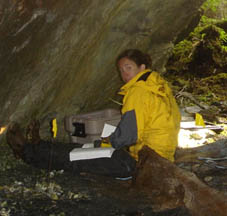
Shona Pierce
Archaeologist, USDA Forest Service
Shona provides archaeological and cultural resource management support to the U.S. Forest Service at the Craig and Thorne Bay Ranger Districts on Prince of Wales Island in Southeast Alaska. Growing up on a rural island in Alaska with school teachers for parents, Shona has been exposed to natural sciences and the history of the Pacific Northwest Coast for as long as she can remember. She received an MA in Anthropology from Western Washington University with a concentration in archaeology. Shona developed a strong passion for archaeology and Alaska Native cultures as a Forest Service seasonal technician beginning nearly 12 years ago. Her experience as a seasonal technician and her love of the outdoors gave her a deep appreciation for how the Forest Service manages both natural and cultural resources.
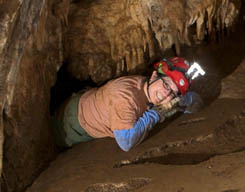
Lizandra Nieves-Rivera
Forest Soil Scientist, USDA Forest Service
Lizandra Nieves-Rivera is the Forest Soil Scientist for the Willamette National Forest in Springfield, OR. In this role, she is responsible for assessing and protecting soil, and geological resources. Lizandra is a native of Puerto Rico with degrees in Geology, Soil Science and Geographic Information Systems (GIS). She began her public career as a Geologist for the Bureau of Land Management and then transferred to a Soil Scientist career with the Forest Service in Colorado, California, and Oregon.
Through her college years and professional career, she has the opportunity to work in groundwater ecosystems modeling, wetland delineation, groundwater depending ecosystems assessment, and spring restoration projects. Her interests in cave came from visiting beautiful karst systems growing up in Puerto Rico and through caving exploration trips with friends in the USA. Her interests are to be able to do international restoration projects and be more involved in caving management and exploration here and internationally.
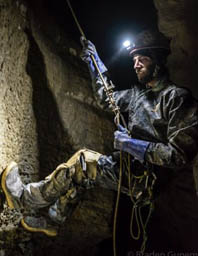
Dr. Ben Tobin
Hydrologist, National Park Service
Dr. Tobin is a hydrogeologist specializing in caves and karst terrain. He received a Master's degree from Western Kentucky University (WKU) focused on the effects of urbanization on cave sedimentation and his Ph.D. from Texas State University focused on the role that karst aquifers play in maintaining river flow in the Sierra Nevada. He is currently the hydrologist and cave specialist at Grand Canyon National Park and is working on efforts to understand aquifer flow patterns in the region and documenting cave resources within Grand Canyon. He has also been actively involved in cave exploration and mapping projects around the world.
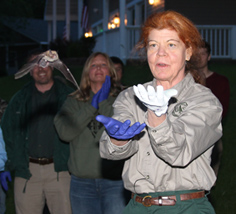
Dr. Sybill Amelon
Research Wildlife Biologist, USDA Forest Service
Dr. Sybill Amelon is a research wildlife biologist with the U.S. Forest Service's Northern Research Station in Columbia, Mo. She earned her PhD in Wildlife Ecology from University of Missouri - Columbia. She has a long career with U.S. Forest Service with field and lab research focused on bat ecology of both endangered and non-endangered bat species. These hypothesis-driven studies address questions related to population demography, behavioral ecology, resource selection, habitat use, diet/nutritional analysis, and energy dynamics. Recent research has focused on understanding and mitigating physiological impacts caused by white-nose syndrome (WNS) and enhancing conservation of surviving bat populations. She integrates field ecology with conservation physiology and nutritional ecology from an "Ecosystem Health" perspective.
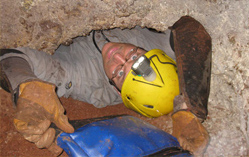
Dr. Steve Taylor
Research Associate, Denver Museum of Nature
Associate Research Professor, Colorado College
Dr. Steve Taylor is a research associate with the Zoology Department, Denver Museum of Science & Nature and an Associate Research Professor with Colorado College. He is interested in the biology, ecology and conservation of invertebrates and vertebrates, especially in sensitive habitats. Steve has worked most extensively with life histories, taxonomy, ecology and conservation of insects and other invertebrates. Much of his recent research has involved studies on caves and groundwater at their intersection with human activities.



















